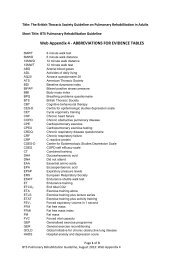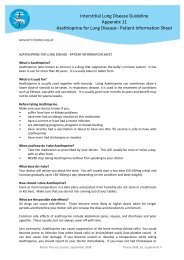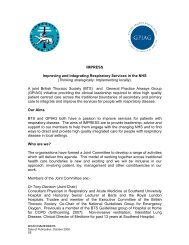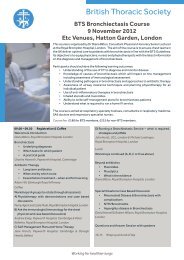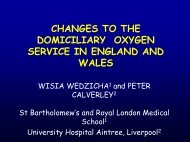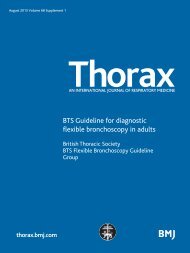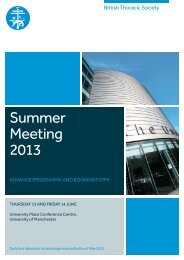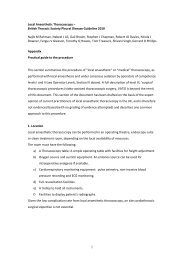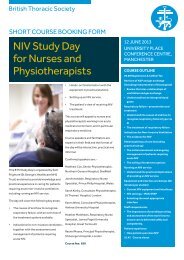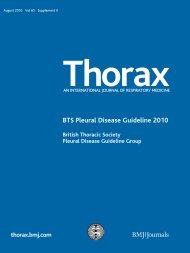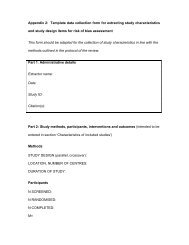Guidelines for the management of community ... - Brit Thoracic
Guidelines for the management of community ... - Brit Thoracic
Guidelines for the management of community ... - Brit Thoracic
Create successful ePaper yourself
Turn your PDF publications into a flip-book with our unique Google optimized e-Paper software.
BTS guidelines<br />
services, with appropriate modification to take into account<br />
differences in licensing and availability <strong>of</strong> antimicrobial agents.<br />
1.5 What patient populations are we including and excluding?<br />
These guidelines address <strong>the</strong> <strong>management</strong> <strong>of</strong> unselected adults<br />
with CAP who are managed by <strong>the</strong>ir general practitioner or<br />
admitted to hospital as an emergency.<br />
Although <strong>the</strong>re are similarities in <strong>the</strong> principles <strong>of</strong> <strong>management</strong><br />
between pneumonic lower respiratory tract infection (ie,<br />
CAP) and non-pneumonic lower respiratory tract infection,<br />
<strong>the</strong>re are differences in <strong>the</strong> aetiology, severity assessment,<br />
<strong>management</strong> and outcome. Recommendations <strong>for</strong> <strong>the</strong> antibiotic<br />
<strong>management</strong> <strong>of</strong> acute exacerbations <strong>of</strong> chronic obstructive<br />
pulmonary disease (COPD) are included in <strong>the</strong> guideline on <strong>the</strong><br />
<strong>management</strong> <strong>of</strong> COPD published by <strong>the</strong> National Institute <strong>of</strong><br />
Health and Clinical Excellence (NICE). 7<br />
We do not consider <strong>the</strong> <strong>management</strong> <strong>of</strong> pneumonia in:<br />
c Patients where <strong>the</strong> pneumonia is an expected terminal event<br />
or who are known to have lung cancer, pulmonary<br />
tuberculosis or cystic fibrosis or primary immune deficiency<br />
or secondary immune deficiency related to HIV infection, or<br />
drug or systemic disease-induced immunosuppression. We<br />
do include patients receiving oral corticosteroid <strong>the</strong>rapy as<br />
this is a not uncommon situation <strong>for</strong> patients admitted on<br />
medical take.<br />
c Patients who have been in hospital within <strong>the</strong> previous<br />
10 days and may have hospital acquired pneumonia.<br />
Patients admitted from healthcare facilities such as nursing<br />
homes and residential homes will be commented on<br />
separately.<br />
c Children with CAP (please refer to <strong>the</strong> BTS guidelines <strong>for</strong><br />
<strong>the</strong> <strong>management</strong> <strong>of</strong> CAP in childhood 8 ).<br />
1.6 What changes have happened in <strong>the</strong> area <strong>of</strong> CAP since <strong>the</strong><br />
2004 guidelines?<br />
c Concerns regarding health care-associated infections<br />
(HCAIs), particularly methicillin-resistant Staphylococcus<br />
aureus (MRSA) and Clostridium difficile infection, have<br />
grown in recent years. These HCAIs are associated with<br />
volume <strong>of</strong> antibiotic use. Antibiotic stewardship should<br />
now be an essential responsibility <strong>for</strong> all clinicians. Measures<br />
to avoid and reduce inappropriate antibiotic use are <strong>the</strong>re<strong>for</strong>e<br />
at <strong>the</strong> <strong>for</strong>efront <strong>of</strong> <strong>management</strong> strategies <strong>for</strong> all<br />
infective episodes. 9<br />
c Fluoroquinolone antibiotics with enhanced activity against<br />
Gram-positive organisms (<strong>the</strong> so-called ‘‘respiratory quinolones’’<br />
such as lev<strong>of</strong>loxacin and moxifloxacin) have been<br />
widely available <strong>for</strong> some years now. Their activity against<br />
most major respiratory pathogens led initially to widespread<br />
use <strong>of</strong> <strong>the</strong>se antibiotics <strong>for</strong> respiratory tract infections,<br />
including CAP. However, more recently <strong>the</strong>se antibiotics<br />
have been associated with both methicillin-resistant S aureus<br />
10 11<br />
(MRSA) and C difficile infections. This has promoted<br />
increasing pressure to limit <strong>the</strong> use <strong>of</strong> <strong>the</strong>se antibiotics in<br />
favour <strong>of</strong> o<strong>the</strong>r classes <strong>of</strong> antibiotics where appropriate. 9<br />
c Antimicrobial resistance in Streptococcus pneumoniae was<br />
noted to rise in <strong>the</strong> late 1990s. Fortunately, a reversal <strong>of</strong> this<br />
trend has been observed in <strong>the</strong> last 5 years, with rates <strong>of</strong><br />
penicillin-resistant S pneumoniae in <strong>the</strong> UK remaining below<br />
4% (see Section 8.4).<br />
c Pneumonia admissions to hospital rose by 34% between<br />
1997–8 and 2004–5. 12 This was matched by an increase in<br />
admissions to intensive care units <strong>for</strong> CAP 13 (see Section<br />
2.1).<br />
Thorax 2009;64(Suppl III):iii1–iii55. doi:10.1136/thx.2009.121434<br />
c<br />
c<br />
c<br />
The processes <strong>for</strong> managing acutely ill medical patients<br />
admitted to hospital have undergone important changes.<br />
The specialty <strong>of</strong> acute medicine has developed substantially<br />
and, in many hospitals, teams run by acute medicine<br />
physicians are already taking responsibility <strong>for</strong> <strong>the</strong> early<br />
stages <strong>of</strong> acutely ill medical patients. This shift, toge<strong>the</strong>r<br />
with <strong>the</strong> demands on junior doctors’ hours arising from <strong>the</strong><br />
European Working Time Directive, mean that patient care<br />
increasingly involves different teams <strong>of</strong> doctors. Effective<br />
handover between teams, careful patient review and<br />
coherent clinical guidelines are key aspects <strong>of</strong> patient<br />
<strong>management</strong> in this context. 14<br />
Timeliness <strong>of</strong> treatment has enlarged as a priority in clinical<br />
care processes. This is perhaps most evident in <strong>the</strong> ‘‘4-hour<br />
admission to treatment’’ target applied to emergency<br />
departments across <strong>the</strong> UK. 15 Increased attention to speed<br />
to treatment as a measure <strong>of</strong> per<strong>for</strong>mance may have <strong>the</strong><br />
inadvertent effect <strong>of</strong> increasing <strong>the</strong> inappropriate or<br />
excessive use <strong>of</strong> antibiotics in patients with suspected but<br />
unconfirmed CAP, thus exacerbating any existing problems<br />
with HCAIs (see Section 8.9).<br />
Newer microbiological tests <strong>for</strong> <strong>the</strong> detection <strong>of</strong> infection by<br />
respiratory pathogens such as urine antigen tests are<br />
becoming increasing available routinely, while previously<br />
established tests such as complement fixation tests are<br />
gradually being phased out.<br />
1.7 <strong>Guidelines</strong> Committee membership<br />
The <strong>Guidelines</strong> Committee was established in January 2008<br />
with representatives from a range <strong>of</strong> pr<strong>of</strong>essional groups<br />
including <strong>the</strong> Royal College <strong>of</strong> General Practitioners, Royal<br />
College <strong>of</strong> Physicians, <strong>Brit</strong>ish Geriatric Society, <strong>Brit</strong>ish Infection<br />
Society, <strong>Brit</strong>ish Society <strong>for</strong> Antimicrobial Chemo<strong>the</strong>rapy,<br />
General Practice Airways Group, Health Protection Agency<br />
and <strong>the</strong> Society <strong>for</strong> Acute Medicine (see Section 11). Three<br />
members in <strong>the</strong> current committee also served on <strong>the</strong> 2001 and<br />
2004 <strong>Guidelines</strong> Committee.<br />
The <strong>Guidelines</strong> Committee agreed <strong>the</strong> remit <strong>of</strong> <strong>the</strong> guidelines.<br />
The Centre <strong>for</strong> Reviews and Dissemination and Centre <strong>for</strong><br />
Health Economics at <strong>the</strong> University <strong>of</strong> York was commissioned<br />
by <strong>the</strong> BTS to undertake literature searches on behalf <strong>of</strong> <strong>the</strong><br />
<strong>Guidelines</strong> Committee.<br />
1.8 How <strong>the</strong> evidence was assimilated into <strong>the</strong> guidelines<br />
1.8.1 Literature searches<br />
Systematic electronic database searches were conducted in order<br />
to identify potentially relevant studies <strong>for</strong> inclusion in <strong>the</strong> CAP<br />
guidelines. For each topic area <strong>the</strong> following databases were<br />
searched: Ovid MEDLINE (including MEDLINE In Process),<br />
Ovid EMBASE, Ovid CINAHL and <strong>the</strong> Cochrane Library<br />
(including <strong>the</strong> Cochrane Database <strong>of</strong> Systematic Reviews, <strong>the</strong><br />
Database <strong>of</strong> Abstracts <strong>of</strong> Reviews <strong>of</strong> Effects, <strong>the</strong> Cochrane<br />
Central Register <strong>of</strong> Controlled Trials, <strong>the</strong> Health Technology<br />
Assessment database and <strong>the</strong> NHS Economic Evaluation<br />
Database).<br />
The searches were first run in December 2007 and were<br />
updated in August 2008. Searches included a combination <strong>of</strong><br />
indexing terms and free text terms, and were limited to English<br />
language publications only. Full search strategies <strong>for</strong> each<br />
database are available in <strong>the</strong> web-based supplement.<br />
1.8.2 Appraisal <strong>of</strong> <strong>the</strong> literature<br />
One individual (HR) read <strong>the</strong> title and abstract <strong>of</strong> each article<br />
retrieved by <strong>the</strong> literature searches and decided whe<strong>the</strong>r <strong>the</strong><br />
iii9



